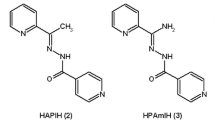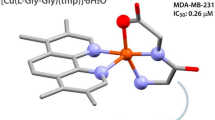Abstract
The synthesis, physico–chemical characterization and cytotoxicity of four copper(II) coordination complexes, i.e. [Cu(HBPA)Cl2] (1), [Cu(BHA)2] (2), [Cu(HBPA)(BHA)Cl] CH3OH (3) and [Cu(HBPA)2]Cl2·4H2O (4), are reported. HBPA is the tridentate ligand N-(2-hydroxybenzyl)-N-(2-pyridylmethyl)amine and HBHA is the benzohydroxamic acid. The reaction between the HBHA and CuCl2.2H2O has resulted in the new complex (2) and the reaction between complex (1) and HBHA has resulted in the new complex (3). X-ray diffraction studies for complex (3) indicated the effective coordination of HBHA as BHA−. Their cytotoxicity was evaluated against three human tumoral cell lines (Colo-205, NCI-H460 and U937) and PBMC (peripheral blood mononuclear cells), using the MTT cytotoxic assay. The results toward PBMC reveal that the new copper(II) complex (2) presents lower toxicity toward normal cells. Furthermore, complex (2) presents IC50 values lower than cisplatin toward NCI-H460 and the best selectivity index obtained towards NCI-H460 (SI = 2.2) and U937 cell lines (SI = 2.0), as a result of the presence of two molecules of HBHA in its structure. Complex (3) presents IC50 values lower than cisplatin toward NCI-H460, Colo-205 and comparable to cisplatin toward U937. The evaluation of the cell death type promoted by complexes (2) and (4) was investigated toward NCI-H460 revealing better results than the standard drug cisplatin, according to the Annexin V and propidium iodide (PI) labeling experiment. Based on the studies here performed, HBHA seems to be related to lower toxicity toward PBMC and HBPA is improving directly the cytotoxity.








Similar content being viewed by others
References
Addison AW, Rao TN, Reedijk J et al (1984) Synthesis, structure, and spectroscopic properties of copper(II) compounds containing nitrogen-sulphur donor ligands; the crystal and molecular structure of aqua[1,7-bis(N-methylbenzimidazol-2′;-yl)-2,6-dithiaheptane]copper(II) perchlorate. J Chem Soc Dalt Trans https://doi.org/10.1039/DT9840001349
Azeredo NFB, Bull ES, Resende JALC et al (2015) Crystal structure and behavior in solution of [Cu(HBPA)2]Cl2·4H2O [HBPA = (2-hydroxybenzyl-2-pyridylmethyl)amine]. J Chem Crystallogr. https://doi.org/10.1007/s10870-015-0617-8
Ballestreri E, Simon D, de Souza AP et al (2018) Resistance mechanism to cisplatin in NCIH-460 non-small cell lung cancer cell line: investigating apoptosis, autophagy, and cytogenetic damage. Cancer Drug Resist. https://doi.org/10.20517/cdr.2017.02
Borges LJH, Bull ÉS, Fernandes C et al (2016) In vitro and in vivo studies of the antineoplastic activity of copper (II) compounds against human leukemia THP-1 and murine melanoma B16–F10 cell lines. Eur J Med Chem. https://doi.org/10.1016/j.ejmech.2016.07.018
Brabec V, Griffith DM, Kisova A et al (2012) Valuable insight into the anticancer activity of the platinum-histone deacetylase inhibitor conjugate, cis-[Pt(NH3)2malSAHA -2H)]. Mol Pharm. https://doi.org/10.1021/mp300038f
BRUKER, APEX2 (2012) Bruker AXS Inc., Madison, WI, USA.
Codd R, Braich N, Liu J et al (2009) Zn(II)-dependent histone deacetylase inhibitors: Suberoylanilide hydroxamic acid and trichostatin A. Int J Biochem Cell Biol 41(736):739
Cooper AL, Greenberg VL, Lancaster PS et al (2007) In vitro and in vivo histone deacetylase inhibitor therapy with suberoylanilide hydroxamic acid (SAHA) and paclitaxel in ovarian cancer. Gynecol Oncol. https://doi.org/10.1016/j.ygyno.2006.09.011
Costa RO, Ferreira SS, Pereira CA et al (2018) A new mixed-valence Mn(II)Mn(III) compound with catalase and superoxide dismutase activities. Front Chem. https://doi.org/10.3389/fchem.2018.00491
Faggi E, Gavara R, Bolte M et al (2015) Copper(ii) complexes of macrocyclic and open-chain pseudopeptidic ligands: synthesis, characterization and interaction with dicarboxylates. Dalt Trans. https://doi.org/10.1039/c5dt01496d
Fernandes C, Horn A, Vieira-da-Motta O et al (2010) Synthesis, characterization and antibacterial activity of FeIII CoII, CuII and ZnII complexes probed by transmission electron microscopy. J Inorg Biochem. https://doi.org/10.1016/j.jinorgbio.2010.07.011
Fernandes C, Horn A, Vieira-Da-Motta O et al (2014) Synthesis, characterization, antibacterial and antitumoral activities of mononuclear zinc complexes containing tridentate amine based ligands with N3 or N2O donor groups. Inorganica Chim Acta. https://doi.org/10.1016/j.ica.2014.02.040
Fernandes C, Horn A, Lopes BF et al (2015) Induction of apoptosis in leukemia cell lines by new copper(II) complexes containing naphthyl groups via interaction with death receptors. J Inorg Biochem. https://doi.org/10.1016/j.jinorgbio.2015.09.014
Geary WJ (1971) The use of conductivity measurements in organic solvents for the characterisation of coordination compounds. Coord Chem Rev. https://doi.org/10.1016/S0010-8545(00)80009-0
Griffith DM, Duff B, Suponitsky KY et al (2011a) Novel trans-platinum complexes of the histone deacetylase inhibitor valproic acid; synthesis, in vitro cytotoxicity and mutagenicity. J Inorg Biochem. https://doi.org/10.1016/j.jinorgbio.2011.03.001
Griffith DM, Szocs B, Keogh T et al (2011b) Suberoylanilide hydroxamic acid, a potent histone deacetylase inhibitor; its X-ray crystal structure and solid state and solution studies of its Zn(II) Ni(II), Cu(II) and Fe(III) complexes. J Inorg Biochem. https://doi.org/10.1016/j.jinorgbio.2011.03.003
Gupta SP, Sharma A (2013) The chemistry of hydroxamic acids. In: Hydroxamic acids: a unique family of chemicals with multiple biological activities
Halaburková A, Jendželovský R, Kovaľ J et al (2017) Histone deacetylase inhibitors potentiate photodynamic therapy in colon cancer cells marked by chromatin-mediated epigenetic regulation of CDKN1A. Clin Epigenetics. https://doi.org/10.1186/s13148-017-0359-x
Hathaway BJ, Billing DE (1970) The electronic properties and stereochemistry of mono-nuclear complexes of the copper(II) ion. Coord Chem Rev. https://doi.org/10.1016/S0010-8545(00)80135-6
Kalfaolu E, Karabulut B (2011) Theoretical investigation of EPR and molecular orbital coefficient parameters for [Cu(hsm)2(sac)2] complex. Chem Phys Lett. https://doi.org/10.1016/j.cplett.2011.02.038
Kenny RG, Marmion CJ (2019) Toward multi-targeted platinum and ruthenium drugs—a new paradigm in cancer drug treatment regimens? Chem Rev 119.2:1058–1137
Kenny RG, Ude Z, Docherty JR, Marmion CJ (2020) Vorinostat and Belinostat, hydroxamate-based anti-cancer agents, are nitric oxide donors. J Inorg Biochem. https://doi.org/10.1016/j.jinorgbio.2019.110981
Kim MS, Blake M, Baek JH et al (2003) Inhibition of histone deacetylase increases cytotoxicity to anticancer drugs targeting DNA. Cancer Res 63(7291):7300
Kivelson D, Neman R (1961) ESR studies on the bonding in copper complexes. J Chem Phys doi. https://doi.org/10.1063/11731880
Kovacic P, Edwards CL (2011) Hydroxamic acids (therapeutics and mechanism): Chemistry, acyl nitroso, nitroxyl, reactive oxygen species, and cell signaling. J Recept Signal Transduct 31(10):19
Končić MZ, Barbarić M, Perković I, Zorc B (2011) Antiradical, chelating and antioxidant activities of hydroxamic acids and hydroxyureas. Molecules. https://doi.org/10.3390/molecules16086232
Luu TH, Morgan RJ, Leong L et al (2008) A phase II trial of vorinostat (suberoylanilide hydroxamic acid) in metastatic breast cancer: a California cancer consortium study. Clin Cancer Res. https://doi.org/10.1158/1078-0432.CCR-08-0122
Maciel LLF, de Freitas WR, Bull ES et al (2020) In vitro and in vivo anti-proliferative activity and ultrastructure investigations of a copper(II) complex toward human lung cancer cell NCI-H460. J Inorg Biochem. https://doi.org/10.1016/j.jinorgbio.2020.111166
Manal M, Chandrasekar MJN, Gomathi Priya J, Nanjan MJ (2016) Inhibitors of histone deacetylase as antitumor agents: a critical review. Bioorg Chem 67(18):42
Marks PA (2007) Discovery and development of SAHA as an anticancer agent. Oncogene 26(1351):1356
Marmion CJ, Parker JP, Nolan KB (2013) Hydroxamic acids: an important class of metalloenzyme inhibitors. In: Comprehensive inorganic chemistry II (second edition): from elements to applications
Maurice AM (1980) Acquisition of anisotropic information by computational analysis of isotropic EPR spectra. (PhD thesis). University of Illinois, Urbana.
Morcelli SR, Bull ÉS, Terra WS et al (2016) Synthesis, characterization and antitumoral activity of new cobalt(II)complexes: effect of the ligand isomerism on the biological activity of the complexes. J Inorg Biochem. https://doi.org/10.1016/j.jinorgbio.2016.05.003
Moreira RO, Morcelli SR, Kanashiro MM et al (2019) Modulating the antitumoral activity by the design of new platinum(II) compounds: synthesis, characterization, DFT, ultrastructure and mechanistic studies. J Inorg Biochem. https://doi.org/10.1016/j.jinorgbio.2018.12.016
Muller PY, Milton MN (2012) The determination and interpretation of the therapeutic index in drug development. Nat Rev Drug Discov 11.10(751):761
Neves A, de Brito MA, Vencato I et al (1993) Synthesis, crystal structure and properties of a new binuclear iron(III) complex as a model for the purple acid phosphatases. Inorganica Chim Acta. https://doi.org/10.1016/S0020-1693(00)87516-7
Park S, Park JA, Kim YE et al (2015) Suberoylanilide hydroxamic acid induces ROS-mediated cleavage of HSP90 in leukemia cells. Cell Stress Chaperones. https://doi.org/10.1007/s12192-014-0533-4
Parker JP, Nimir H, Griffith DM et al (2013) A novel platinum complex of the histone deacetylase inhibitor belinostat: Rational design, development and in vitro cytotoxicity. J Inorg Biochem. https://doi.org/10.1016/j.jinorgbio.2013.03.011
Rieger AM, Nelson KL, Konowalchuk JD, Barreda DR (2011) Modified annexin V/propidium iodide apoptosis assay for accurate assessment of cell death. J Vis Exp. https://doi.org/10.3791/2597
Rodrigues DA, Ferreira-Silva GA, Ferreira ACS et al (2016) Design, synthesis, and pharmacological evaluation of novel n-acylhydrazone derivatives as potent histone deacetylase 6/8 dual inhibitors. J Med Chem. https://doi.org/10.1021/acs.jmedchem.5b01525
Saban N, Bujak M (2009) Hydroxyurea and hydroxamic acid derivatives as antitumor drugs. Cancer Chemother Pharmacol 64:213
Sheldrick GM (2008) A short history of SHELX. Acta Crystallogr Sect A Found Crystallogr 64:112
Silva GC, Parrilha GL, Carvalho NMF et al (2008) A bio-inspired Fe(III) complex and its use in the cyclohexane oxidation. Catal Today. https://doi.org/10.1016/j.cattod.2007.12.036
Sirichanchuen B, Pengsuparp T, Chanvorachote P (2012) Long-term Cisplatin exposure impairs autophagy and causes cisplatin resistance in human lung cancer cells. Mol Cell Biochem. https://doi.org/10.1007/s11010-011-1199-1
Ungerstedt J, Du Y, Zhang H et al (2012) In vivo redox state of Human thioredoxin and redox shift by the histone deacetylase inhibitor suberoylanilide hydroxamic acid (SAHA). Free Radic Biol Med. https://doi.org/10.1016/j.freeradbiomed.2012.09.019
Wang XX, Wan RZ, Liu ZP (2018) Recent advances in the discovery of potent and selective HDAC6 inhibitors. Eur J Med Chem 143:1406–1418
Wlodkowic D, Telford W, Skommer J, Darzynkiewicz Z (2011) Apoptosis and beyond: cytometry in studies of programmed cell death a review on hydroxamic acids: widespectrum chemotherapeutic agents. Int J Biol Biomed Eng. https://doi.org/10.46300/91011.2020.14.12
Acknowledgements
The authors are grateful to financial support received from CNPq (Conselho Nacional de Desenvolvimento Científico e Tecnológico) and FAPERJ (Fundação de Amparo à Pesquisa do Estado do Rio de Janeiro), and Capes (Coordenação de Aperfeiçoamento de Pessoal de Nível Superior) for the scholarship.
Author information
Authors and Affiliations
Corresponding author
Additional information
Publisher's Note
Springer Nature remains neutral with regard to jurisdictional claims in published maps and institutional affiliations.
Supplementary Information
Below is the link to the electronic supplementary material.
Rights and permissions
About this article
Cite this article
Azeredo, N.F.B., Borges, F.V., Mathias, M.S. et al. Effect of the hydroxamate group in the antitumoral activity and toxicity toward normal cells of new copper(II) complexes. Biometals 34, 229–244 (2021). https://doi.org/10.1007/s10534-020-00275-9
Received:
Accepted:
Published:
Issue Date:
DOI: https://doi.org/10.1007/s10534-020-00275-9




